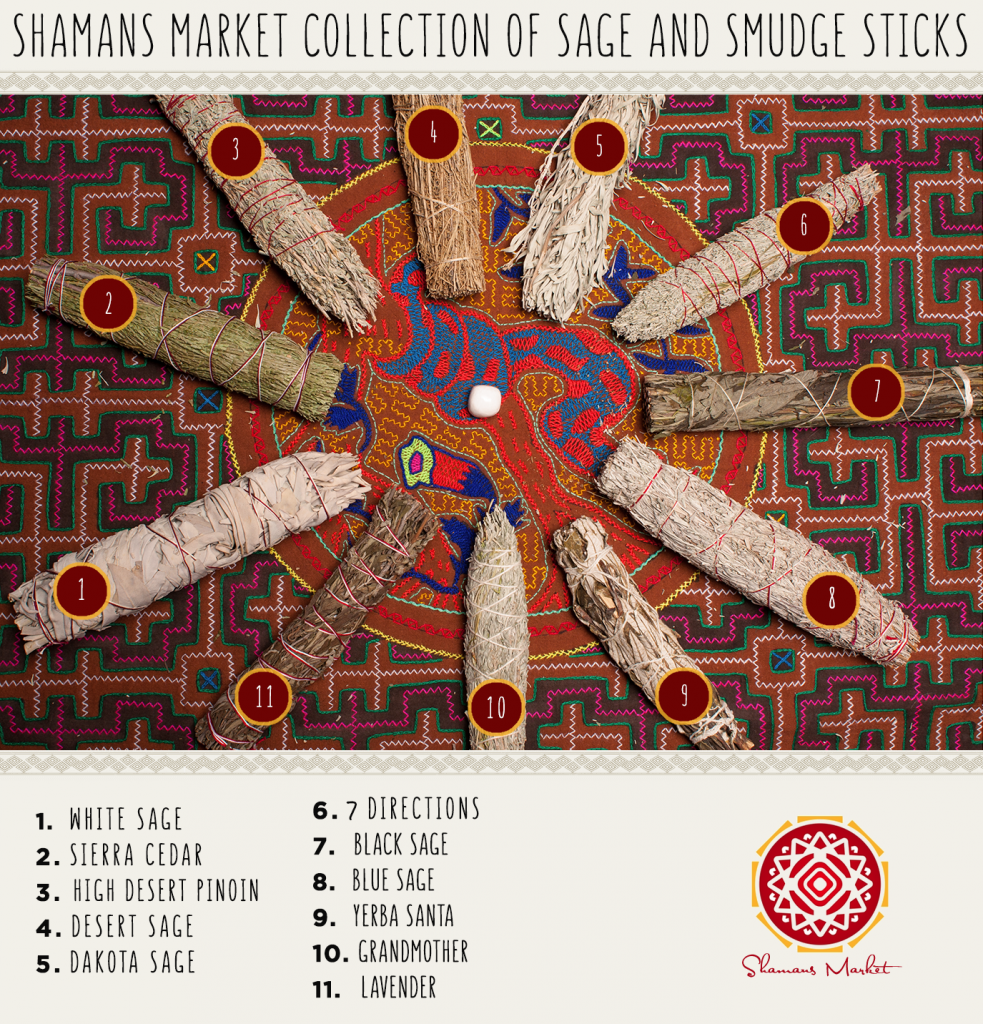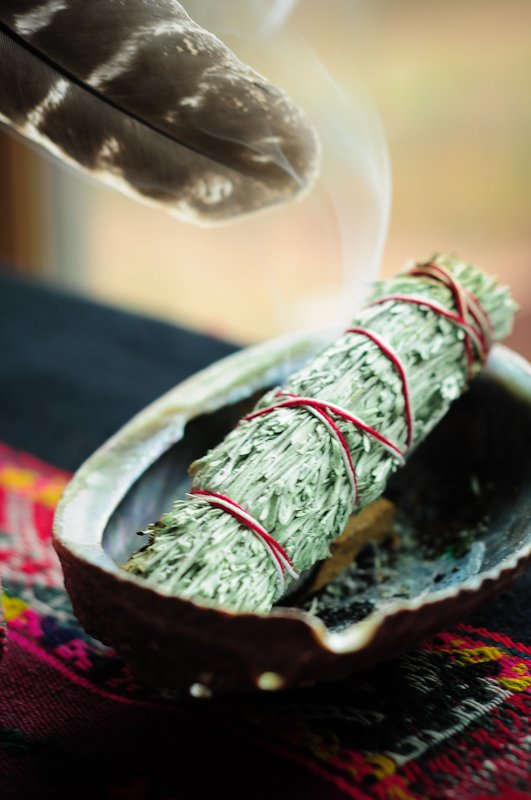
The Wisdom of North American Sage
Gabrielle LucciAll plants are our brothers and sisters.
They talk to us and if we listen, we can hear them.
— Arapaho Proverb
smudge stick form of incense frequently is associated with North American culture. To discuss the act of smudging and use of smudge sticks is tricky business. It’s safe to say that native cultures across North America use smoke in their ceremonies, yet many myths surrounding smudging persist.
Burning Plants to Create Ceremonial Smoke
A popular belief is that the act of smudging using smudge sticks of white sage for purification and cleansing originated in the Americas by Native North Americans. Not so. While they may have burned plant material to create smoke, they did not invent the act of smudging, nor did they only burn white sage. And while it’s hard to say who invented smudging or the first smudge stick, it cannot be attributed to Native North Americans. They did burn herbs for purification and cleansing. And so did others. According to Jon Hanna, expert on language usage, “Burning or otherwise using common sage, and other plants called sage…for purification or warding off evil or sickness is a very old European tradition.” The Himalayan cultures have a similar tradition though the plants used are different, usually native to their areas.

Sage By Any Other Name
Some believe the only proper smudge stick is made from sage and the only proper sage is White Sage, Salvia apiana. However, different sages are used, such as Black Sage. They are identifiable by having Salvia as their Latin genus names. Culinary sage, the kind you might have on your kitchen spice rack, is Salvia officinalis. It grows in the Mediterranean (Iberia and Balkans) and northern Africa, so not native to North America. Other plants used include those having Artemisia as their Latin genus. Oftentimes species of Artemisia are misnamed as sage: Dakota Sage is actually one of the common names for Artemisia ludoviciana; Artemisia tridentata is commonly called Blue Sage. Prairie Sage, also called Pasture Sagewort, is actually Artemisia frigidaare. We won’t even go into the fact that one plant can have many common names, that the same common name can be applied to different plants and a single plant may have many cultivars, hybridizations or cogeners.
Where the Sage and Artemisia Dwell
While many plants used in smudge sticks come from the US West and Southwest, some plants are found as far north as Canada and far south as Mexico. Dakota “sage” grows all over the badlands of South Dakota in Louisiana and New Mexico. White sages thrive in windswept deserts, and grow wild across the American Southwest. Black and Blue Sages are common in the coastal scrub of Southern California and northern Baja California, Mexico. When contrasting the ranges of S. apiana and Artemisias on a map, one can readily see the range for Artemesia is much larger than the range for S.apiana. Perhaps that could explain the use of the Artemesia as a stand-in for Salvias in some smudge sticks. Elder Wilfred Buck, of the Opaskwayak Cree Nation, alludes to this in sharing knowledge passed on by his elders: “Where ever you go in North America, one of those plants [sage, sweetgrass, tobacco or cedar] will be growing.” Perhaps the wisdom conveyed by his elders is that Great Spirit provides what one needs; that one seek whatever plant is available for one’s intention and it will be found.
“Where ever you go in North America, one of those sacred plants (Sage, Sweetgrass, Tobacco or Cedar) will be growing.”
– Elder Buck, Opaskwayak Cree Nation

Native North American Traditional Usage
Native Americans have harvested smudging plants for thousands of years. The tradition of using Salvias, Artemisias and other native North American plants, as ceremonial smoke or in smudge pots for cleansing and purification continues within the Native North American culture today; The Chumash of the central and southern coastal regions of California, the Plains Indians, eastern groups like Cree, Ojibwe and Cherokee all use smoke for smudging and local plants for burning. Black Sage is also a powerful smudge for purification and cleaning. Justin Neely, Director, Citizen Potawatomi Nation says “…people will often smudge off their pipes and eagle feathers before using them. They will use sage to get rid of any negativity and sometimes they will mix other medicines in as well. Smudging is smoke that rises up that we run our spiritual items through before using them and something we do to people before entering a ceremony. We also bless certain areas such as the dance arena and even the room we do general council at before we start the meeting.”
“Smudging is smoke that rises up that we run our spiritual items through before using them and something we do to people before entering a ceremony. We also bless certain areas such as the dance arena and even the room we do general council at before we start the meeting.”
– Justin Neely, Potawatomi Nation
Medicinal Uses
All salvias have medicinal qualities. Besides being used for smudging, sage leaves can be made into a tea. The Chumash have a very precise way of making tea from white sage, although some sources say that sage species should not be used internally. Their traditional medicine includes black sage leaves and stems made into a strong sun tea for rubbing on painful areas or used as a foot soak for relieving pain. The Ohlone California Indian nation drank Black Sage leaf decoctions to cure coughs; placed leaves in baths to cure limb paralysis; held heated leaves against the ear to reduce earache pain, or wrapped them around the neck to relieve sore throat pain. Artemisia have medicinal properties too. The plant is associated with tonic, cardiac, nervine, vasodilatory, diuretic, antiseptic and anti-fungal properties. Many Native Americans used species of Woodworm Artemisia as a tea for stomach ailments and bronchitis. The Yokias of Mendocino County used their native Artemisia species for remedies too. A word of caution, however. Do not use any herbs medicinally or mix with other medicines unless you have expert guidance.
Metaphysical Properties
Sage is used to create a protective field around a space. Author Jane Alexander in her article Smudging, says “It [smudging] is the equivalent of spiritual spring cleaning.” Some types of sage smudge are used for astral travel, shamanic journeying, and for protection during such excursions. It is believed White Sage cleanses a place of negative vibes or energies and evil spirits while at the same time attracts good vibes and positive energies. Other plants are used for their metaphysical properties. “Along with Rosemary, Cedar is one of the most aggressively cleansing smudges you can choose….Sometimes combined with sage, Yerba Santa is burned to honor ancestors, increase psychic powers, and bring healing and protection. It is excellent for emotional and soul blockages and helps to release grief, despair and melancholy, which can be held in the heart and lungs,” says author Michelle Gruben in her article Sage advice: An illustrated guide to smudging herbs. The Spanish came to know of Yerba Santa’s medicinal value through Native Americans, who either smoked it or made infusions of it.
Smudge Sticks and Books and Gift Boxes
Here at Shamans Market we offer many different kinds of smudge sticks, featuring Salvias, Artemisias and other traditional smudge plants, such as Cedar and Yerba Santa. We offer different sizes too, from 3 inch to 11 inch bundles. Some “torch” style sticks have longer stems still attached to the leaves. New to smudging? We have books that can guide your smudging initiation or expand your existing knowledge:
- Sage and Smudge: Secrets Of Clearing Your Personal Space
- The Smudging and Blessings Book: Inspirational Rituals to Cleanse and Heal by Jane Alexander
- Smudging for Beginners: Secrets from a Professional by LeeZa Donatella
- Sacred Smoke: The Ancient Art of Smudging for Modern Times by Harvest McCampbell.
And for a special occasion for family or friends, consider our White Sage Smudge Gift Box.
Shamans Market Offerings
Black Sage
Black Sage Smudge Sticks – 8 in & Mini -3 in
Blue Sage
Blue Sage Smudge Sticks 6.5 in., 8 in and
Dakota Sage Incense Stick 11 in
Desert Sage Smudge Stick 8 in
White Sage
White Sage Mini Smudge Stick-BULK/each, 8-9 in.11 in, 5 in, Torch Style Smudge Stick-4 in, Mini smudge Sticks-3 Pak-3.5 in
White Sage Blends
White and Blue Sage Large – 8-9 in.
White and Black Sage – 8 in
White Sage and Lavender – 3-4 in
White Sage and Lavender Large 8-9 in.
White Sage and Cedar Large 8-9 in.
White Sage and Rosemary Large 8-9 in.
White Sage & Yerba Santa Incense Bundle 7 in.
Other Sage Blends
Dakota Sage & Cedar 10 in
Mountain Sage & Lavender Large 8-9 in.
Multi Herb Sticks
High Desert Pinon Smudge Stick
Trees
Other Plants
Lavender 7-8 inch, 3-4 inch, 6-7 in
Yerba Santa 6- 7 in., 9 in., 3-4 in.
Added Resin
The post The Wisdom of North American Sage appeared first on Shamans Market .





